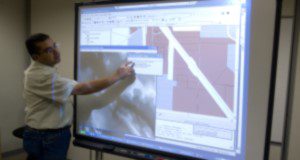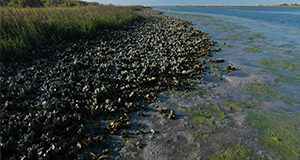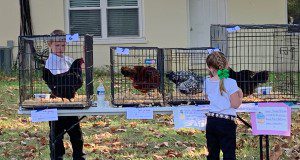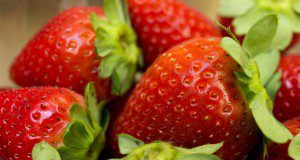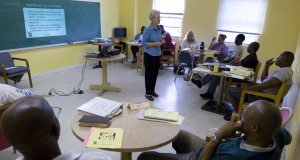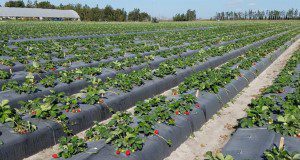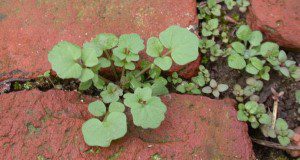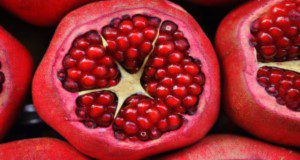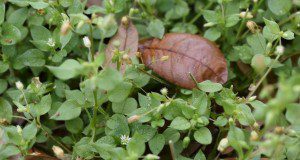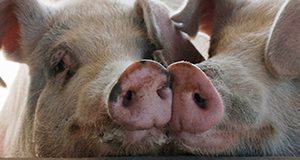The Cetaceans 4th Grade Curriculum provides a series of individual lessons covering cetacean (whale and dolphin) biology and ecology. The curriculum uses charismatic megafauna to engage students and inspire them to want to learn more. This 3-page document provides a brief overview of the Cetaceans 4th Grade Curriculum. Written by Maia Patterson McGuire and Ruth Francis-Floyd, and published by the UF/IFAS Veterinary Medicine–Large Animal Clinical Sciences Department, June 2019.
http://edis.ifas.ufl.edu/vm225
Tips for Delivering Effective Presentations
At some point, most people are faced with the daunting task of delivering a presentation. These presentations could be required by job responsibilities, as an academic assignment, or in roles within the community. Presentations may be delivered to small or large audiences. Giving a presentation in front of an audience may be a frightening endeavor; however, this new 4-page publication of the UF/IFAS Department of Agricultural Education and Communication provides five steps to make the task of giving a presentation easier and ensure that your presentation will be effective. Written by Brianna Shanholtzer, Andrew C. Thoron, and J. C. Bunch.
https://edis.ifas.ufl.edu/wc337
Bok Choy, an Asian Leafy Green Vegetable Emerging in Florida
Asian vegetable crops are rapidly expanding in Florida in the last decade due to their health benefits combined with their high profitability. These crops can help increase vegetable growers’ income and diversify Florida’s crop production, and they are new to most Floridians. This new 5-page article provides a general overview of bok choy for vegetable growers, crop consultants, certified crop advisors, Extension agents, and graduate students. Written by Hai Liu and Guodong Liu and published by the UF/IFAS Horticultural Sciences Department.
https://edis.ifas.ufl.edu/hs1337
Cetaceans 4th Grade Curriculum–Lesson 13: North Atlantic Right Whale Migration
This 6-page document is the thirteenth lesson in the Cetaceans 4th Grade Curriculum. It contains information that will help students learn about the migration path of North Atlantic right whales and the ways researchers are studying the movement of these whales. Written by Maia Patterson McGuire and Ruth Francis-Floyd, and published by the UF/IFAS Veterinary Medicine–Large Animal Clinical Sciences Department, June 2019.
http://edis.ifas.ufl.edu/vm238
Florida 4-H Poultry Project Record Book
The Florida 4-H Poultry Project Record Book is designed as a tool for Florida 4-H members to keep records for their dual-purpose or show flocks. The Florida 4-H Poultry project’s purpose is to acquire an understanding of poultry production by preparing for, purchasing, breeding, caring for, and keeping records on one or more chickens or other poultry species. This 18-page major revision by Chris Decubellis is based on the original edition by L. W. Kalch and is a publication of the UF/IFAS Extension 4-H Youth Development Program.
https://edis.ifas.ufl.edu/4h038
Tung Oil Production in Florida
Tung tree seed produce an oil that is valuable in wood finishing and for various other uses. Development of a later-flowering tung tree cultivar has sparked renewed interest in tung seed as a potential alternative crop for northern and central Florida on sites having relatively well-drained, fertile soils and adequate moisture. This 3-page fact sheet written by Pat Minogue and published by the UF/IFAS School of Forest Resources and Conservation presents a history of tung oil production in Florida and provides the ecology and cultivation of the fast-growing trees. It outlines a plan for additional research to determine whether tung oil could again be produced in Florida.
http://edis.ifas.ufl.edu/fr420
Rodenticides
Rodenticides are pesticides designed to kill rodents, primarily mice and rats. However, rodents are not the only species that can be poisoned by rodenticides. Practically any mammal, including humans, can suffer severe effects from unintentional exposure to rodenticides. Rodenticides vary widely in the hazard they present even though they are all designed to kill animals that are physiologically comparable to humans. This new 4-page publication of the UF/IFAS Pesticide Information Office addresses those hazards for rodenticides currently registered in Florida. Written by Frederick M. Fishel.
https://edis.ifas.ufl.edu/pi284
Cetaceans 4th Grade Curriculum–Lesson 7: How Do Whales Eat?
This 10-page document is the seventh lesson in the Cetaceans 4th Grade Curriculum. It contains information that will help students learn the differences between how baleen and toothed whales feed. Students will also learn how sound waves are used for echolocation. Written by Maia Patterson McGuire and Ruth Francis-Floyd, and published by the UF/IFAS Veterinary Medicine–Large Animal Clinical Sciences Department, June 2019.
http://edis.ifas.ufl.edu/vm232
Phytophthora Crown Rot of Strawberry
This new 3-page article describes Phytophthora crown rot, an important disease in Florida strawberry fields caused mainly by Phytophthora cactorum, and provides some recommendations for cultural and chemical control. Written by Natalia A. Peres and Juliana S. Baggio and published by the UF/IFAS Plant Pathology Department.
https://edis.ifas.ufl.edu/pp350
Making Action Easier: Behavioral Economics and Nudges for Extension Professionals
As Extension turns more to effecting behavior change beyond simply raising awareness or understanding concerns, how do we not only help clientele make a change, but make it easier? Behavioral economics principles can improve the way we present options to clients, increasing the likelihood of them choosing desirable behaviors. This new 3-page publication of the UF/IFAS Department of Agricultural Education and Communication offers an introduction to these concepts as well as practical strategies for setting up the environment for change. Written by Laura Warner, Kathryn Stofer, and Hayk Khachatryan.
https://edis.ifas.ufl.edu/wc343
Conducting the Needs Assessment #4: Audience Motivations, Barriers, and Objections
A successful needs assessment is contingent on participation from the right people, so understanding potential motivations, barriers, and objections specific to your participants is critical. This new 5-page publication, the fourth in the Conducting the Needs Assessment series, provides Extension educators and other service providers with an overview of motivations, barriers, and objections specific to participants in needs assessments. Written by Laura Warner and Matt Benge and published by the UF/IFAS Department of Agricultural Education and Communication.
https://edis.ifas.ufl.edu/wc342
Fusarium Wilt (Fusarium oxysporum f. sp. niveum) of Watermelon
Fusarium wilt of watermelon is one of the most serious and difficult diseases to manage and occurs in most production regions worldwide. The fungus can be seedborne and has great longevity in the soil, allowing infested soil to also serve as a source of infection. This new 4-page publication of the UF/IFAS Plant Pathology Department signs, symptoms, and the disease cycle of Fusarium wilt and provides recommendations for cultural and chemical management. Written by Pamela Roberts, Nicholas Dufault, Robert Hochmuth, Gary Vallad, and Mathews Paret.
https://edis.ifas.ufl.edu/pp352
The UF/IFAS Strawberry Clean Plant Program
Florida strawberry growers primarily utilize cultivars developed by the UF/IFAS Strawberry Breeding Program. These cultivars are bred to provide the yield and quality traits needed by the Florida industry. Yet if a new cultivar has the traits that Florida growers need but pathogen-tested planting stock is not available to growers, the cultivar’s impact will be limited. The Clean Plant Program generates the pathogen-tested planting stock that nurseries and growers require. This new 5-page publication of the UF/IFAS Horticultural Sciences Department, written by Catalina Moyer, Natalia A. Peres, and Vance M. Whitaker, is intended to educate both the industry and the public on the importance of the Clean Plant Program and the methods used to produce planting stock of new cultivars.
https://edis.ifas.ufl.edu/hs1343
Stock Plant and Tree Production: Weed Management in Citrus Nurseries
All citrus nursery stock in Florida is raised in enclosed greenhouses. It is not uncommon for weeds to grow in containers, where they compete with citrus seedlings, and on greenhouse floors, where they can harbor pests and diseases. This new 7-page publication of the UF/IFAS Horticultural Sciences Department provides descriptions of a few commonly found weeds in citrus nurseries and good weed management practices. Written by Biwek Gairhe, Ramdas Kanissery, and Brent Sellers, this article is chapter 8c of the forthcoming Citrus Nursery Production Guide.
https://edis.ifas.ufl.edu/hs1344
Diseases of Pomegranate (Punica granatum) in Florida
Pomegranate production is becoming increasingly popular in the Southeast. Florida’s humid subtropical to tropical climate is favorable for not only pomegranate tree establishment, but also several diseases. This new 5-page publication of the UF/IFAS Plant Pathology Department, written by Katia V. Xavier, Achala N. KC, and Gary E. Vallad, describes the various diseases affecting pomegranate in Florida and provides some management recommendations.
https://edis.ifas.ufl.edu/pp349
Culturally Responsive Teaching: A Framework for Educating Diverse Audiences
As the diversity of Extension clientele continues to grow, it is important for Extension educators to consider new ways of supporting this population. The purpose of this new 5-page article is to provide a framework for educating diverse audiences to assist in helping these audiences attain the learning outcomes of Extension education programs. This includes: (1) acquiring a knowledge base of diverse cultures, (2) designing or utilizing culturally relevant curricula, (3) utilizing cultural caring and developing a learning community, (4) practicing intercultural communications, and (5) establishing cultural congruity in classroom instruction. Written by John Diaz, Cecilia Suarez, and Laura Valencia and published by the UF/IFAS Department of Agricultural Education and Communication.
https://edis.ifas.ufl.edu/wc341
Biology and Management of Common Chickweed (Stellaria media) in Ornamental Crop Production
Chickweed is a common cool-season annual weed in Florida landscapes, container nurseries, home gardens, and other agricultural production systems. This new 5-page article is written for green industry professionals and others to aid in the identification and management of chickweed in and around ornamental plants. Written by Yuvraj Khamare, Chris Marble, Nathan Boyd, and Shawn Steed and published by the UF/IFAS Environmental Horticulture Department.
https://edis.ifas.ufl.edu/ep577
Common Hazards to Consider during Manufacturing of Feeds for Swine
This 8-page document discusses common biological, chemical, and physical hazards that may need preventive measures during the manufacture of swine feeds. Written by Taylor Langford, Morgan McKinney, Chad Carr, and Jason M. Scheffler, and published by the UF/IFAS Department of Animal Sciences, September 2019.
http://edis.ifas.ufl.edu/an357
Cetaceans 4th Grade Curriculum: Lesson 6: Cetacean Behaviors
This 4-page document is the sixth lesson in the Cetaceans 4th Grade Curriculum. It contains information that will help students learn about whale and dolphin behaviors. Written by Ruth Francis-Floyd and Maia Patterson McGuire, and published by the UF/IFAS Veterinary Medicine–Large Animal Clinical Sciences Department, June 2019.
http://edis.ifas.ufl.edu/vm231
Cetaceans 4th Grade Curriculum: Lesson 11: Introduction to Right Whales
This 10-page document is the eleventh lesson in the Cetaceans 4th Grade Curriculum. It contains information that will help students learn about North Atlantic right whale life history. Written by Ruth Francis-Floyd and Maia Patterson McGuire, and published by the UF/IFAS Veterinary Medicine–Large Animal Clinical Sciences Department, June 2019.
http://edis.ifas.ufl.edu/vm236

